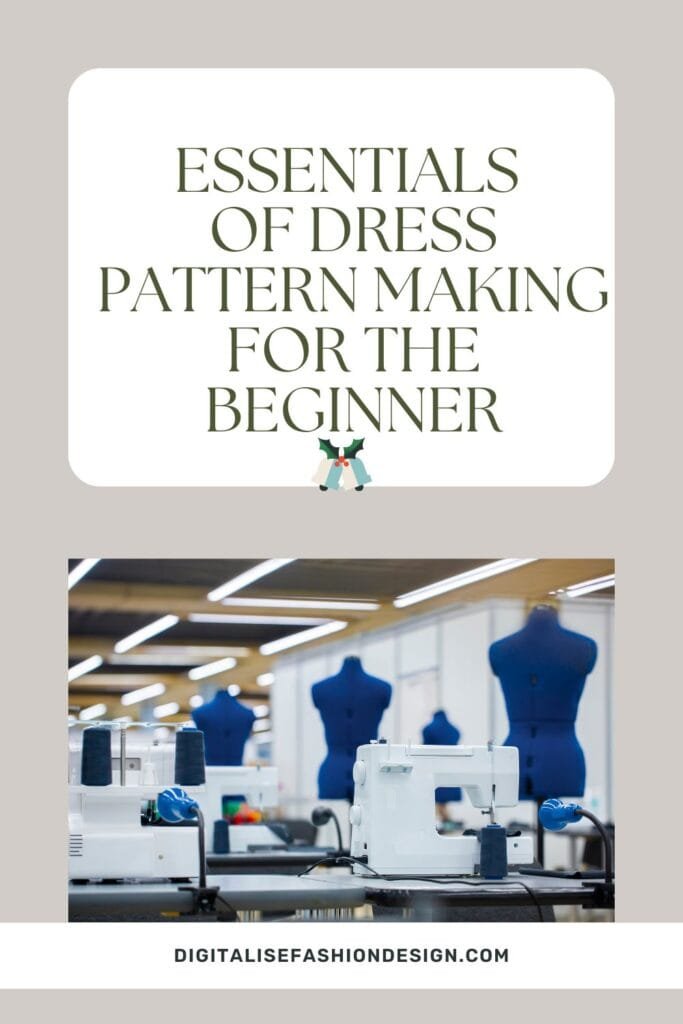Creating a stunning garment is a work of art that involves a meticulous process, and at the heart of this process lies pattern drafting. Whether you’re an aspiring fashion designer, a clothing manufacturer, or simply someone who loves creating unique outfits, understanding the essentials of dress pattern drafting is crucial. In this article, we’ll dive deep into the world of pattern making, clothing production, and design. Let’s explore how to get it right from start to finish.
Table of Contents
- Introduction to Pattern Making
- The Clothing Manufacturing Landscape
- Importance of Fashion Design in Pattern Drafting
- Collaboration with Garment Manufacturers
- Utilizing Tech Pack Templates
- The Role of CAD Software in Pattern Drafting
- Educational Pathways: Fashion Schools and Institutes
- Step-by-Step Guide to Pattern Creation
- Unveiling the Clothing Production Process
- Understanding Pattern Grading
- Pattern Drafting in the Apparel Industry
- Bringing Designs to Life: Clothing Brands and Fashion Designers
- Navigating Garment Production in the Fashion Landscape
- Establishing Your Clothing Line
- The Fusion of Textile Design and Pattern Drafting
- Paving Your Way: Enrolling in a Fashion Institute
- Innovations in Clothing Factory Techniques
- Mastery of Pattern Cutting
- Creating Artistic Fabric Patterns
1. Introduction to Pattern Drafting

Pattern-drafting is the foundation of every well-fitted garment. It involves creating templates that guide the cutting and assembly of fabric pieces to create a three-dimensional outfit that fits beautifully.
Understanding Pattern Drafting: The Foundation of Fashion Design
Pattern-making serves as the blueprint for any successful fashion design project. It’s the process through which designers transform their creative ideas into tangible garments that fit impeccably. Every stitch, fold, and seam is meticulously planned in the pattern, ensuring the final product looks and feels just right.
2. The Clothing Manufacturing Landscape
The world of clothing manufacturing is a complex web of creativity and engineering. Garments transition from sketches to wearable art through various production stages.
3. Importance of Fashion Design in Pattern Drafting
Fashion design brings aesthetics and functionality together. A well-designed pattern ensures that the final garment not only looks good but also feels comfortable to wear.
Imagine this: just like directors bring movie scripts to life, pattern makers transform designs from paper to wearable marvels.
They’re the magic behind making sure your vision translates seamlessly into the real world of fabrics. Think of them as the bridge between your creative spark and the touchable textures of your clothing.
4. Collaboration with Garment Manufacturers
Working closely with garment manufacturers is essential to bring your designs to life efficiently. Communication and collaboration are key.
5. Utilizing Tech Pack Templates
Tech packs are detailed documents that outline every aspect of a garment’s production. These templates streamline the manufacturing process and ensure consistency.
6. The Role of CAD Software in Pattern Drafting
Computer-Aided Design (CAD) software revolutionized pattern drafting. It allows designers to create, modify, and visualize patterns digitally before actual production.
7. Educational Pathways: Fashion Schools and Institutes for pattern drafting
Enrolling in a fashion school provides you with formal education and hands-on training, fostering your creativity and honing your technical skills.
Choosing the Right Place to Learn pattern drafting
Selecting the right institution or platform to learn dress pattern drafting is crucial to your success. While there are various options available, both online and offline, it’s essential to opt for a reputable source that provides comprehensive and in-depth instruction. Here are some avenues to consider:
1. Fashion Design Schools
Attending a renowned fashion design school offers a structured and immersive learning experience. Institutions like the Fashion Institute of Technology (FIT), Parsons School of Design, and Central Saint Martins are renowned for their comprehensive fashion programs, which often include courses dedicated to pattern drafting. These institutions provide hands-on training, access to industry experts, and a chance to network with fellow aspiring designers.
2. Online Learning Platforms
In today’s digital age, online learning platforms have gained immense popularity for their convenience and flexibility. Websites like Udemy, Skillshare, and Coursera offer a range of pattern-making courses suitable for all skill levels. These platforms allow you to learn at your own pace, often with video tutorials, interactive assignments, and opportunities for instructor feedback.
3. Local Workshops and Classes
If you prefer a more hands-on approach, attending local workshops and classes can provide valuable learning experiences. Many sewing studios and community centers offer classes in dress pattern drafting. These smaller settings can offer personalized attention, allowing you to grasp intricate techniques and receive direct guidance from experienced instructors.
RELEVANT YOUTUBE VIDEOS
Curriculum Highlights
Regardless of the learning avenue you choose, a comprehensive dress pattern-drafting course should cover essential topics to ensure you’re well-equipped for success:
– Basic Pattern Drafting: Learn the fundamentals of pattern drafting, including taking accurate body measurements, creating basic blocks, and understanding ease and seam allowances.
– Advanced Techniques: Delve into more intricate techniques such as manipulating darts, creating pleats, adding gathers, and designing various necklines and sleeves.
– Fitting and Adjustments: Master the art of fitting garments perfectly to different body types, addressing common fit issues, and making necessary adjustments.
– Digital Pattern Making: Explore the world of computer-aided design (CAD) and learn how to create digital patterns using specialized software.
8. Step-by-Step Guide to Pattern drafting
Pattern drafting involves translating a design into a blueprint for sewing. This step-by-step process requires precision and attention to detail.
Selecting a Design
Before diving into pattern creation, choose a design concept for your garment. Whether it’s a sleek evening gown or a casual t-shirt, understanding the design elements is essential to drafting an accurate pattern.
2. Taking Measurements
Our comprehensive measurement guide helps you gather precise body measurements. Remember, accuracy at this stage directly impacts the fit of the final garment.
3. Creating the Pattern
Using your measurements as a foundation, start drafting the pattern on pattern paper or using digital tools. Pay close attention to grain lines, seam allowances, and other critical details.
4. Making a Prototype
Once your pattern is ready, create a prototype using muslin fabric. This step allows you to test the fit and make necessary adjustments before using the final fabric.
Advanced Techniques for Expert Pattern Drafting
1. Adding Complexity with Darts and Pleats
Darts and pleats add dimension and shape to your garments. Mastering the art of placing and sewing these elements elevates your patterns from basic to sophisticated.
2. Incorporating Design Variations
Learn how to modify your patterns to create various design iterations. Experiment with necklines, sleeves, and hemlines to develop a diverse range of garment options.
other interesting blog post
Types of Patterns in Clothing Manufacturing
Understanding the different types of patterns used in clothing manufacturing is essential for anyone involved in the fashion and apparel industry.
**1. Block Pattern
The block pattern, also known as the basic or sloper pattern, forms the foundation for garment construction.
It is a template devoid of style elements or design features.
The block pattern is created based on standard body measurements and is used as a starting point for developing various garment designs.
Designers and pattern makers modify the block pattern to incorporate design details, such as pleats, darts, and seam placements, to create unique garments.
Five main garment components create the base pattern in womenswear:

- Front bodice
- Back bodice
- pants
- Sleeve
- Fitted skirt
**2. Draping Pattern
Draping, often referred to as “moulage,” involves manipulating fabric directly on a dress form to create a three-dimensional garment shape. This method allows designers to experiment with different silhouettes and fabric drapes, resulting in unique and artistic designs. Draping patterns are often used in high-fashion and couture settings, where creativity and innovation are paramount.
**3. Drafted Pattern
Drafted patterns are created using mathematical calculations and measurements. Pattern makers use a set of equations and measurements to draw the pattern pieces directly onto paper or fabric. This method ensures precision and accuracy in pattern creation. Drafted patterns are commonly used in mass production settings, as they allow for consistency in sizing across multiple garments.
**4. Graded Pattern
Grading involves creating patterns in various sizes to cater to a diverse range of body measurements. A graded pattern maintains the design elements of the original garment while proportionally increasing or decreasing measurements to fit different sizes. Graded patterns are crucial for offering ready-to-wear clothing lines that cater to a wide customer base.
**5. Composite Pattern
A composite pattern is a combination of multiple pattern pieces that come together to create a complex garment. It involves intricate sewing and construction techniques, often used in elaborate designs such as wedding dresses, ball gowns, and theatrical costumes. Composite patterns require advanced skills and attention to detail.
**6. Printed Pattern

these kind of patterns are commercial patterns available to home sewers and designers alike. These patterns come with detailed instructions and pre-drawn pattern pieces on large sheets of tissue paper. Sewers can cut out the pattern pieces, follow the provided instructions, and sew their own garments. Printed patterns are convenient for those who want to create garments without drafting patterns from scratch.
**7. Computer-Generated Pattern
In the modern age of technology, computer-generated patterns have gained prominence. Using specialized software like Audaces 360, Tailornova, CLO and Marvelous Designer, pattern makers can create digital patterns with precise measurements and design details. These patterns can be easily adjusted, resized, and stored electronically, streamlining the design and manufacturing processes.
**8. Adapted Pattern
Adapted patterns are modifications of existing patterns to suit specific design preferences or requirements. This could involve altering neckline shapes, adjusting sleeve lengths, or changing the placement of design elements. Adapted patterns allow designers to customize existing templates without starting from scratch.
9. Unveiling the Clothing Production Process
From selecting fabrics to quality control, the clothing production process is multifaceted. Each stage plays a crucial role in delivering a high-quality garment.
10. Understanding Pattern Grading
Pattern grading involves scaling a base pattern to create various sizes while maintaining design proportions. It’s an essential skill for accommodating diverse body types.
Once you have the initial pattern for your garments, the next step is to create alternative sizing.
DOWNLOAD YOUR MEASUREMENT WORKSHEET FOR YOUR BASIC BLOCK PATTERN DRAFTING
This process is called pattern grading and involves making other sizes using your basic blueprint.
Some manufacturers have standard guidelines for grading, and this is where you see common retailer measurements. For example, size 8 and beyond, sizes S, M, L, and so on.
Pattern grading doesn’t have to be complicated once you have the basic outlines. However, there are two systems to determine the grading.
- Draft technique: This system applies increments to the pattern draft as a whole.
- Track technique: This grading applies increments to the individual pattern pieces and essentially alters section by section.
To make this process easier, you can use computer-aided design (CAD) software to grade your patterns.
11. Pattern Drafting in the Apparel Industry
Pattern drafters are essential professionals in the apparel industry. They bridge the gap between design and manufacturing, ensuring the accurate translation of designs into patterns.
In the realm of fashion and garment production, the creation of patterns finds its hub in various settings. Among major apparel manufacturers, the presence of one or more adept pattern makers is customary. These skilled artisans undertake the responsibilities of sewing construction and all matters pattern-related.
On the other hand, independent pattern makers, operating as freelancers, follow a more flexible work arrangement. They might opt to work from the comfort of their homes or establish private studios.
12. Bringing Designs to Life: Clothing Brands and Fashion Designers
Clothing brands and designers are the driving force behind the fashion industry. Their creative vision and unique styles shape the trends of the season.
13. Navigating Garment Production in the Fashion Landscape
Garment production requires coordination of resources, labor, and machinery. Efficient production techniques are vital for meeting market demands.
14. Establishing Your Clothing Line
Turning your design dreams into a successful clothing line involves strategic planning, branding, and understanding your target audience.
15. The Fusion of Textile Design and Pattern Drafting
Textile design and pattern drafting go hand in hand. The choice of fabric and its pattern significantly influence the final garment’s look and feel.
Now, you have a comprehensive understanding of dress pattern drafting and its significance in the fashion industry. Whether you’re a budding fashion designer or an entrepreneur venturing into the clothing business, mastering these essentials will set you on the path to success.
FAQs
- What is the primary role of pattern drafting in garment creation? Pattern drafting serves as the blueprint for cutting and assembling fabric pieces to create well-fitted garments.
- How does CAD software enhance pattern drafting? CAD software enables designers to create and modify patterns digitally, improving accuracy and efficiency in the design process.
- What is the importance of pattern grading? Pattern grading ensures that a design can be scaled to different sizes while maintaining its original proportions.
- Why is collaboration with garment manufacturers crucial? Collaboration with manufacturers ensures that your design vision is translated accurately into the final product.
- How can enrolling in a fashion school benefit aspiring designers? Fashion schools provide formal education, practical skills, and a platform to nurture creative talent in aspiring designers.








